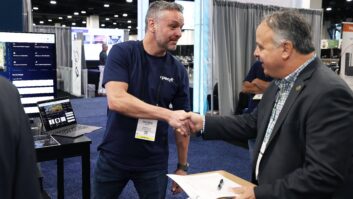There is just so much to soak in from CEDIA that it can’t be covered in one show wrap, especially when that wrap was dedicated to the best surround demos I experienced at the show. And as cool as those demos were, CEDIA is even more about integration solutions that will help us moving forward and less about the awesome sound of a TIE fighter screaming by overhead.
Here are five things—both categories and products—that caught my eye while cruising the showfloor. If anything really stood out to you, please let us know about it in the comments!
1) Wireless Audio
There are just so many terrific solutions out there that it would be hard to imagine any integration company not embracing some wireless audio system by this point, and CEDIA had some major announcements from three of the biggest players in the wireless audio space.
Sonos had a steady line outside its booth to experience the new Play5 speaker as well as the company’s forthcoming Trueplay room correction. Trueplay will use the microphone in an iOS device to tune the speaker for optimized sound in the room. The company demo’d a Play1 in the corner of the room turning Trueplay correction on and off and it made a marked difference, correcting bloated bass and tightening up vocal clarity. This is going to be a free add-on to Sonos speakers and it will be easy to demonstrate the improvements. While I think not renaming the Play5 speaker is a bit confusing, the new Play5 is a quantum performance leap for the company, and I literally said, “Wow!” when they started playing the new speaker as it produced stunning amounts of bass. When they switched the demo and had two speakers playing together as a stereo pair, the audio rivaled that of many tower speakers. I know it’s hard to believe that “Sonos” and “high-end” could be used together, but these new speakers are flat out amazing. If you’ve been avoiding Sonos because of perceived audio quality issues, the Play5 will give you reason to reconsider.
On the DTS Play-Fi front we saw new product launches from Paradigm, Anthem, and MartinLogan. Most of these products will include ARC (Anthem Room Correction), which is the same technology featured in Anthem’s D2 Statement processor to deliver the best audio in any room. The company demonstrated the benefits of ARC using Play-Fi through a new Paradigm speaker, and it was stunning—almost producing a night-and-day sound difference in the small demo room. The new Paradigm PWAMP also delivered impressive audio, easily driving a pair of Paradigm tower speakers while coaxing significant amounts of bass from them. The PWAMP can be bridged into mono for even more power, meaning you could easily add a couple of PWAMPs to a pair to speakers and have reference audio with virtually no gear. Anthem is launching three new receivers—and a pre-amp—that will be the first of their kind to have Play-Fi built in and MartinLogan will have a new Motion Vision X soundbar with Play-Fi built-in.
With the CI channel in focus, Fusion Research showed that the Play-Fi Server that can integrate the technology with third-party control systems like Control4, URC, Crestron, RTI, and more. This single device can serve up six streams—three to traditional components via digital and analog outputs and three via wireless Play-Fi. This lets Play-Fi speakers and components become part of a larger, integrated housewide control system.
A lesser known but very impressive wireless system brand, Bluesound, who showed off its second-generation products. The entire Bluesound line-up has been redesigned with numerous upgrades and improvements to the Gen2 models, including a new battery-powered speaker for truly portable listening. I’m receiving review samples from both Bluesound and Paradigm, so look for a detailed review coming soon.

Sony debuted three new 4K projectors. Pictured are Mike Fasula and ‘Tank’ Tanikawa
2) 4K Everywhere
While CEDIA has seen a lot of the non-projector video manufacturers abandon ship, there were still many 4K announcements at the show. First, Sony debuted three new 4K projectors, including a flagship laser model with infinite black levels. LG showed its uber-gorgeous 4K OLED display with black level so deep and colors so vibrant that I actually started hating my Pioneer Elite 9G Kuro the more I looked at it. And VIZIO was on hand displaying its over-the-top 120-inch 4K Reference Series set at its own booth and with the Powerhouse Alliance, which offers first-time distribution of the brand to the CI channel. In addition, Digital Projection (DPI) showed its new Insight 4K Dual-LED, 3-chip DLP model that produced absolutely stunning images on a 16-foot wide screen with colors that were literally off the charts. (The Rec 720 charts! AV humor!)
But the big takeaway from CEDIA 2015 was that the industry is finally ready for true 4K video distribution. Every receiver, matrix, and extender is now HDMI 2.0 and HDCP 2.2 and ready for the future of housewide 4K video distribution. Further, many devices were also HDMI 2.0a, making them ready for high dynamic range (HDR) content.
One massive disappointment—for me at least—was the lack of any Ultra HD Blu-ray players at the show. I figured Sony would have had something or that someone would have borrowed the recently announced Panasonic player for demos, but that wasn’t the case. (At least not that I saw. If you got into one of those closed-room, extra-secret demos to see it, my hat’s off to you!) However, that didn’t mean that there wasn’t any good news for 4K content. DISH demonstrated its new 4K Joey, which will be available to subscribers at no additional cost compared with a regular Joey and is so thin you can slip it behind all but the flattest of flat screens. PRIMA Cinema demonstrated its second-generation movie player that will play first-run Hollywood content in 4K, along with a new partnership announcement with Dolby to deliver Atmos as well. PRIMA partnered with DPI and the true 4K, full Rec 709 color content made your eyes weep for all the beauty in the world.
The biggest 4K content news was from Kaleidescape. Not only did the company display its new Strato line of 4K servers and players featuring a gorgeous 4K GUI with 60 fps animation for ultra-smooth transitions, it also announced its third-generation movie store that will feature more than 100 4K titles at launch—the most 4K content currently available anywhere. Kaleidescape is very optimistic that it will be able to add 4K titles as they become available, and the company will support HDR content as it becomes available, too. Kaleidescape demonstrated the Strato playing back 4K HDR content on an LG 4K OLED, and it was everything you would hope it could be.

Kaleidescape’s Cheena Srinivasan at CEDIA
Both Wyrestorm and Key Digital debuted some very cool and surprisingly affordable 4K matrixes that will likely appeal to sports fans, business moguls, and anyone else that loves to watch multiple programs at once. Capable of displaying four full 1080p images on a 4K display (or four 960×540 images on a 1080p display), the matrixes can also display one large image with three smaller resized images for a PiP on steroids. A second output can either display one main screen or a mirror of the four-screen image.
As we transition out of HDCP 1.4 and into 2.2 you are going to want to get familiar with Key Digital’s HDFix22. It’s quite possible this little box-of-magic could become your new best friend and save you from having to tell a customer that they need to make a massive upgrade to get a picture. The HDFix22 provides HDCP 2.2 authentication, allowing non 2.2-equipped displays to show true 4K content. The Fix can also resolve EDID issues, provides an audio breakout, manages TMDS re-clocking, and can let you extend your cabling runs.
3) Control
You can’t hold a CEDIA show without having all the major control and automation companies breaking out their latest wares, and there were plenty of announcements to be had. The big news from Crestron, Clare Controls, and Savant has already been covered by Todd Puma and Maureen Jenson, so I’ll start with Control4, which really impressed with the rollout of its latest operating system, OS2.8. One of the things I really love about Control4 is that much like Apple, the company continues to update its OS and delivers new features free of charge each time. That latest OS gives users access to native Pandora, Tidal, and Deezer streaming, really improves security integration, and does an amazing overhaul to its Music and Movies navigation, delivering a really terrific, graphic-rich cover art browsing view.
URC showed new devices in its Total Control platform, the TRC-820 remote, and MRX-8 network controller. These devices will retail for under $1,000 and give users full system control along with unlimited licenses for adding iOS and Android control apps on multiple devices. The wand remote features full 2-way IP control and has a 2-inch LCD screen that can display video streams from IP cameras, metadata from Sonos, Nest thermostats, Honeywell security, Lutron lighting systems, and more. By adding a URC Z-wave gateway, you can also integrate Z-wave devices into the home’s Total Control system.
Lutron’s big news was its new battery-powered Triathlon WIDR shades can now be ordered in sizes from 20.5 inches wide to up to 12-feet wide in up to 12-foot heights. This opens the product line to far more jobs as battery power makes retrofit installations a breeze and now supports most residential window sizes. The company also has a new Battery Boost option that can extend battery life by up to 80 percent for roller shades that are 38 inches and wider, delivering up to six years of performance from standard D-cell batteries.
4) Metra’s HDMI-over-Coax Matrix
Nearly every home still has an RG6, coax cable backbone, and the folks at Metra have found a way to harness this existing infrastructure to deliver an incredibly affordable, massive HDMI matrix distribution system delivering 1080p resolution to distances greater than 2,000 feet. The M3B—Metra Multimedia Broadcast—can deliver up to 100 sources to an infinite number of displays using a simple combination of transmitters (one per source), receivers (one per TV), existing RG6 coax cabling and simple, and off-the-shelf cable splitters. Each transmitter is assigned a channel and then the receiver “tunes” to that channel. Combined with a control system, the MB3 can be a very powerful video distribution system costing factors less than other solutions.

Metra’s Miranda Grantham at CEDIA
5) SnapAV’s Luma Surveillance
Surveillance is becoming a big part of many integrators’ businesses and SnapAV’s Wirepath series of cameras and DVRs have always been popular choices since launching a few years ago. At this CEDIA Snap demonstrated its new, completely redesigned Luma Series. With both analog and IP models available, the interface on Luma is outstanding, whether locally or remotely using the app, making it easy for users to find and review specific events, zoom in on any point in the image, snip out segments to save and export, and more. The Luma Series analog cams will deliver 1080p resolution over coax using HD-TVI technology, but the Luma DVRs will also be backwards compatible with traditional analog cameras. On the IP side, the Luma Series NVRs will feature a built-in PoE switch to make them plug-and-play with Snap’s line of IP cameras, and the cameras will be offered in good, better, best ranges. Also impressive is that the systems will include integration drivers to work with Control4, Crestron, URC, and ELAN g!







